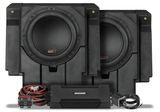Getting To Know Your FOX Shocks
Getting To Know Your FOX Shocks
Getting to know how FOX Shocks are built and how they work can be extremely beneficial when adjusting and tuning your shocks on your ride.
An off-road driver and one of FOX's top shock tuners, Mike Kim, is going to show the components of a shock and a little about how they work.
Mike offers insight into shocks of all sorts, not just the ones on a race car. No matter what you drive trucks, Jeeps, UTV's, snowmobiles, bikes, or bicycles, his expertise is important. The main task of any shock is to give you control over your vehicle's motion by turning the motion into heat. That is what the shocks do both during compression and recovery.
Compression
Compression is when the shock compresses to a collapsed state.
Rebound
Rebound is when the shock extends back to full extension.
We will cover two main categories that are relevant regardless of what type of shock you have or the vehicle you 're driving.
- Springs
- Dampers
Springs
Springs are the first piece of the puzzle that will give you control over your vehicle's motion. Springs store motion of kinetic energy and release it. They also ensure that you and your vehicle ride are at the proper height.
Coil-Spring Shocks
Most bicycles and snowmobiles will have air shocks where the air is in the spring rather than a steel coil, but for now, we will focus on coil-spring shocks. A coil shock can be used with one or more Springs, depending on the application. Many coil-spring shocks like the one in the picture above will have a single spring, but other vehicles on each of their shocks can use two or more Springs.
Dual-Rate Spring Setup
Now it's common to see a dual-rate coil-over, so you can't find Springs out on the long travel shock are long enough to run a single spring, so typically two Springs are stacked on top of each other.
Another reason to run a dual-rate spring setup is to provide more comfort at the start of the stroke and more end-stroke support. Working together, these two Springs give the shock a light initial spring rate and a supportive ending spring rate.
It has the preload adjuster or ride height adjuster, and then it has the crossover rings, and it has the spring divider. Moving down the very end is a spring retainer, and inside there are also spring retainer clips that hold the spring valve.
When running a dual-rate spring setup, both Springs compress together until the spring divider hits the crossover rings.
Dampers
The damper absorbs energy, which the spring stores and releases. They are the final piece of the puzzle in converting motion to heat and, in doing so, allow you to control your vehicle.
Shock Body
It may be either a coil-over, a bypass, or a smooth body, but it is often considered a shock body. Bicycle and motorcycle forks are another type of shock and operate on the same principles.
Shaft
These come across in various diameter lengths. The shaft joins the shock body while the shock compresses and leaves the shock body as the shock rebounds at the very end of the shock.
Body Cap
The body cap lies at the end of the shock 's body. Usually, this has a spherical bearing.
Remote Reservoir
With the shock in the image above, there is a remote reservoir, a remote reservoir hose and then a reservoir assembly with the reservoir body and the reservoir end caps at the ends as well.
Bottom Out Bumper
Shocks have the bottom out bumper. These are made in different sizes, different materials.
Eyelet
At the end is the eyelet, and these again come in different lengths and sizes.
What’s inside the Shock Body?
It is completely full of oil inside the shock body. It has a piston with shims for valving and a number of other parts.
The piston assembly is made up of the valving shims and piston. As the piston assembly moves through the oil and the shock body, the shims in the valves restrict the flow of oil through the piston.
This slows the shaft and spring movement by converting motion into heat. Now the oil will pass through the remote reservoir hose. It goes into the reservoir. Another piston known as the internal floating piston or IFP is in this reservoir.
This part of it normally filled with oil in a reservoir like this, and then the other part of it filled with nitrogen, and IFP would split the two. It 's important to use an IFP to separate the oil from the nitrogen to prevent the oil from foaming up.
The oil that is foamed from the two mixtures together can cause you to lose control. Thus, with this being a hydraulic shock absorber, the way the shock feels can be changed by changing the way the oil flows through certain components.
Ways to Gesture a Shock
There are multiple ways of the gesture a shock. It can be done either by adjusting the shims on the piston from the inside of the shock, or if the shock is fitted with a DSC adjuster, the compression can be changed through the DSC adjuster.
Some of the Fox shocks have rebound adjusters so that the rebound can be adjusted externally. Some rebound adjusters are located on the eyelet at the bottom of the shaft but maybe in a different location on some shocks.
There are a variety of ways to fine-tune the ride of shocks both internally and externally.












